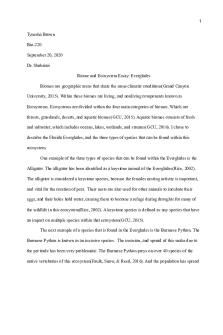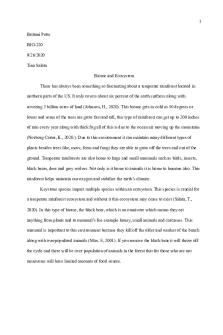Biome Table PDF

| Title | Biome Table |
|---|---|
| Author | noor qureshi |
| Course | Ecology |
| Institution | The University of Western Ontario |
| Pages | 4 |
| File Size | 118.5 KB |
| File Type | |
| Total Downloads | 72 |
| Total Views | 167 |
Summary
biome table unit 1...
Description
Biome
Growth form(s)
Seasonal temperatures
Seasonal precipitation
Important environmental factor(s)
Major threats?
Tropical rainforest
Broad-leaved evergreen and deciduous trees
Warm near-constant
Very high
Light
Logging and agriculture
Tropical seasonal forests & savannas (tropical dry forests, thorn woodlands and tropical savannas)
Grasses, shrubs, fewer trees than rainforests
Annual temp is 24.5
Seasonal
Lower tree densities Increasing drought Leaves drop from tree during the dry season
Major fires influence the vegetation growth form (increases length of dry seasons)
Alot of rain is sept-april
Seasonal flooding contributes to savannas Human development Deserts
Stem succulence Drought deciduous shrubs and grasses Some plants are only active after sufficient precipitation
High temps
Low precipitation
Low water avail High pressure zones of hadley cells which inhibit formation of storms and precipitation High rates of evapotranspiration
low water avail is constraint of desert plant and their functions Long term droughts with grazing practices can result in loss of plant cover (desterfication)
Temperate grasslands
Some can support forests but dominance of grass To get enough supplies of water and nutrients grasses grow more roots than stems and leave
Increasing periods of subfreezing temperatures towards the poles
Enough precipitation to support a forest
Rates of grazing by animals can exceed capacity of plants to produce new tissues
Warm, moist summers and cold dry winters
Grassland degradation
very windy Irrigation of grassland soils reduces fertility
Rich organic matter accumulates in soil and enhance fertility
Increased forest invasion into grasslands
Average 9.1 degrees
Frequent fires Boreal forest
Coniferous species Including spruces, pines and larches (deciduous needles leaves specie)
Very cold Subfreezing temps Low air temp
Precipitation is low
The extreme weather in these subarctic regions is an important determinant of the vegetation structure.
Permafrost During summer droughts forests are more susceptible to fires ignited by lightning Forest growth enhances permafrost formation by
lowering the amount of sunlight absorbed by the soil surface (kills the tree) Logging occurs Climate warming results in rapid decompo and higher rates of carbon release from boreal forest soils increasing greenhouse gas concentrations which causes more warming
Tundra
Sedges, forbs, grasses and low growing shrubs; lichens and mosses
Similar to boreal forest; temp. is cold, precipitation is low and permafrost is widespread
Temperate evergreen forest
Needle-leaved conifers (i.e. pines, junipers and douglas fir
- Warm coastal zones to cool continental and maritime climates - commonly found on nutrient-poor soils
Low precipitation, permafrost is widespread
- arctic but can also be found on the edges of the antarctica peninsula and islands in the southern ocean - northern and southern hemispheres
Temperate shrubland
- evergreen shrubs and trees; allows plants to be active during cooler, wetter periods and also lower their nutrient requirements
- winter, rainy season
- winter rainy season - precipitation falls in winter, and hot, dry weather occurs throughout late spring, summer and fall
-
Temperate deciduous forest
Oak, maple, beech, shorter trees, shrubs and forbs below the canopy
Periods of freezing weather
Enough rainfall to support tree growth
Limited to the northern hemisphere...
Similar Free PDFs

Biome Table
- 4 Pages

Biome Chart
- 2 Pages

Biome Assignment
- 3 Pages

Biome Diorama Project
- 1 Pages

Biome-Activity-Educator
- 5 Pages

Savanna biome - Grade: B
- 3 Pages

Biome and Ecosystem Essay
- 3 Pages

Biome and Ecosystem Essay
- 4 Pages

Biome and Ecosystem
- 5 Pages

Biome and Ecosystem Essay
- 4 Pages

Aquatic biome chart
- 5 Pages

Biome and Ecosystem
- 5 Pages

Biome and Ecosystem
- 4 Pages

IR Table IR Table IR Table
- 6 Pages
Popular Institutions
- Tinajero National High School - Annex
- Politeknik Caltex Riau
- Yokohama City University
- SGT University
- University of Al-Qadisiyah
- Divine Word College of Vigan
- Techniek College Rotterdam
- Universidade de Santiago
- Universiti Teknologi MARA Cawangan Johor Kampus Pasir Gudang
- Poltekkes Kemenkes Yogyakarta
- Baguio City National High School
- Colegio san marcos
- preparatoria uno
- Centro de Bachillerato Tecnológico Industrial y de Servicios No. 107
- Dalian Maritime University
- Quang Trung Secondary School
- Colegio Tecnológico en Informática
- Corporación Regional de Educación Superior
- Grupo CEDVA
- Dar Al Uloom University
- Centro de Estudios Preuniversitarios de la Universidad Nacional de Ingeniería
- 上智大学
- Aakash International School, Nuna Majara
- San Felipe Neri Catholic School
- Kang Chiao International School - New Taipei City
- Misamis Occidental National High School
- Institución Educativa Escuela Normal Juan Ladrilleros
- Kolehiyo ng Pantukan
- Batanes State College
- Instituto Continental
- Sekolah Menengah Kejuruan Kesehatan Kaltara (Tarakan)
- Colegio de La Inmaculada Concepcion - Cebu

